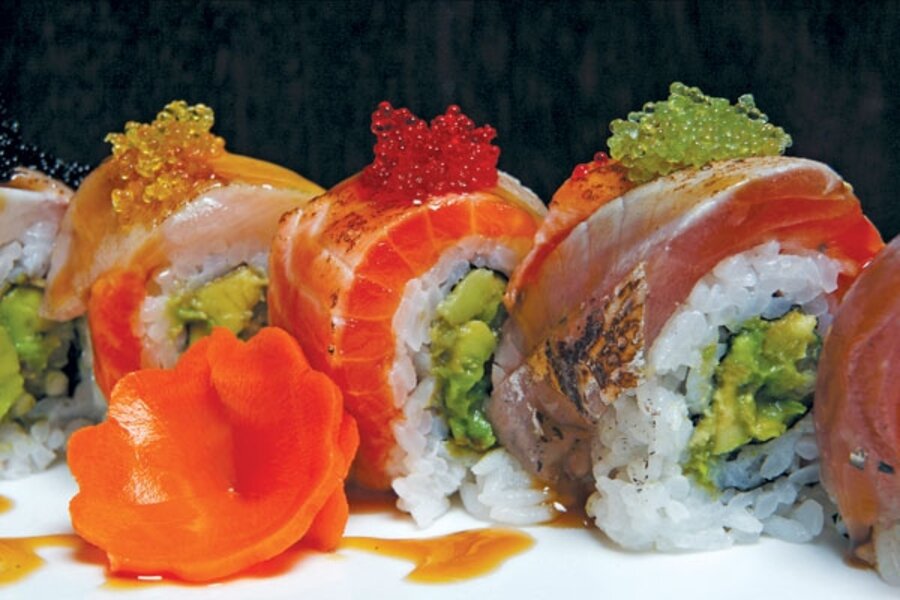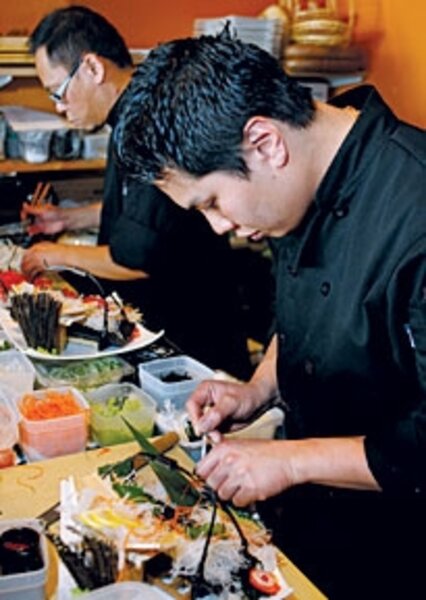Guilt-free sushi
Loading...
As consumers’ love affair with seafood continues to grow, so does the pressure on populations of popular fish. Many species such as red snapper, Atlantic halibut, West Coast salmon, and cod are considered overfished. And fishing methods, such as bottom trawling for monkfish and other species, can destroy important habitat.
So conservation groups have come up with downloadable and printable guides to seafood that are aimed not only at those who enjoy eating fish, but also the growing legions of sushi fans. Sushi bars and restaurants are expected to continue to grow at 10 to 20 percent annually for the next five years, according to a report in Seafood Business magazine. And sushi isn’t confined to restaurants anymore. It’s found at mainstream grocery stores and served in college dining halls. It’s even sold at convenience stores.
Many of the fish used for sushi – Atlantic bluefin tuna and common octopus, for instance – are not considered environmentally sustainable. Diners who want to avoid bad choices may not know what fish they’re really eating, though, since sushi is often given Japanese names.
But some restaurateurs, concerned about dwindling fish populations, are now making it easier for consumers: They’re giving the true name of the fish, telling where it came from, and explaining how it was caught. More important, they’ve taken fish on the “avoid” lists off the menu.
Tataki Sushi and Sake Bar in San Francisco is much more than just a bluefin tuna-free zone, although there’s plenty of common catch absent from the menu here – no farm-raised salmon or shrimp, no unagi (freshwater eel), no tuna caught using long lines.
Instead, chefs and co-owners Kin Lui and Raymond Ho tweak traditional sushi items by substituting fish such as Arctic char that’s been raised in closed systems with little risk of pollution and effect on habitat in place of salmon that’s been farm- raised in an open-cage system. They buy kampachi that’s farmed in the ocean off Hawaii rather than hamachi from farms that may use untraceable feed and raise the fish on land or in freshwater ponds. The shrimp are either trap-caught spot prawns from British Columbia or US wild shrimp.
The chefs even put their own spin on traditional unagi by producing that same sultry, dark taste using sustainable sablefish.
“Our ‘fauxnagi’ is one of our proudest creations,” says Casson Trenor, a partner in Tataki and author of “Sustainable Sushi: A Guide to Saving the Oceans One Bite at a Time.”
“The eel-farming industry is incredibly toxic from start to finish,” he says, “and we refuse to bring it in. The ‘fauxnagi’ offers the same unagi experience without any of the negative environmental effects.”
Bamboo Sushi in Portland, Ore., became the first independent restaurant in the US to be certified by the Marine Stewardship Council (MSC) when it opened in November 2008. That means that the fish they serve – such as black cod, halibut, scallops, albacore tuna, Alaskan salmon, and Oregon pink shrimp – come from fisheries that have undergone a rigorous assessment for sustainability and environmental responsibility.
“Being certified is most important,” says owner Kristofer Lofgren. “Take buildings, for example. If you want to promote that it’s super eco-friendly, people will ask you about the LEED [Leadership in Energy and Environmental Design] certification. It ensures that you’re paying for something tangible. With us, you don’t have to just trust the chef that the fish is sustainable. We have the certification. That’s where we’re different.”
Brad Ack, a regional director for MSC, says the “chain of custody” system was set up for the retail environment, but they’ve readapted it for food service. It’s a two-part certification: one for the fisheries and another for the entire supply chain.
Mr. Ack believes that this helps raise awareness: “You can’t see what’s going on in the ocean like you can with clear-cut logging. Overfishing and other [ocean] damage hasn’t risen in the minds of consumers like deforestation ... but we’re getting there.
“Bamboo was really gung-ho and excited about the program,” he adds, “and we’re [now] being approached by other restaurants and restaurant chains. Sustainability is becoming an issue for their customers.”
Educating their customers on the various ecolabels they’ve earned – including MSC certification and certification by the Green Restaurant Association – is one of the biggest challenges at Bamboo Sushi, says Mr. Lofgren. Staff members have a 95-page manual and go through extensive training on menu items and sustainability issues.
For customers, education comes through eating.
“We’re big fans of flights,” which offer customers the opportunity to sample variations of the same food, says Lofgren. “During the salmon season, Bamboo will offer five different types of salmon from five different areas. If it’s tuna season, we’ll serve skipjack, yellowfin, another grade of yellowfin, blackfin, and albacore. In the winter, we did five different types of crab. It allows people to understand that these creatures all have a history, and it affects taste.”
Adding on a sushi bar to an existing restaurant has been a popular trend in recent years. Rick Moonen, executive chef of RM Seafood in Las Vegas and a longtime proponent of sustainable fishing, moved his raw seafood bar to another part of the restaurant in 2007 to make room for a sushi bar.
When the Monterey Bay Aquarium launched its sushi wallet card (see sidebar below), bumping fresh-water eel and Australian- and Japanese-farmed hamachi to the red “avoid” column, Mr. Moonen immediately removed them from his menu.
Even though it was the right thing to do, it wasn’t easy, he says. “The hard one for me was breaking my love affair with hamachi. I’ve gotten over many things, but that was tough.”
In search of a replacement, Moonen flew to Hawaii to inspect the operations of Kona Blue Water Farms. After grilling the owners about the sustainability of their fish, Moonen now offers Kona Kampachi on his menu as a replacement for hamachi.
Sheila Bowman, senior outreach manager for the Monterey Bay Aquarium’s Seafood Watch program, says that what’s different about Bamboo, Tataki, and other restaurants with similar philosophies is that the owners are making strong personal commitments to the ocean.
“They approached it as ‘We are going to do a business that’s sustainable’ versus ‘We want to do sushi, and let’s tweak it so it’s less bad for the environment,’ ” says Ms. Bowman.
Other restaurants have made different decisions. In May, a group of Greenpeace protesters made headlines by drawing attention to famed chef Nobu Matsuhisa’s offering of bluefin tuna at his global chain of 24 Nobu restaurants. Celebrities Elle Macpherson, Sting, and others signed a letter threatening a boycott.
So far, the endangered fish is still served, although the menu now includes an asterisk informing customers the fish is “environmentally challenged” and suggesting that diners ask for an alternative, thus leaving the decision up to the customer.
Online guides to choosing ocean-friendly sushi
Environmental Defense Fund,
Smart Sushi Choices
Blue Ocean Institute,
Seafood Guide
Monterey Bay Aquarium,
Seafood Guide






